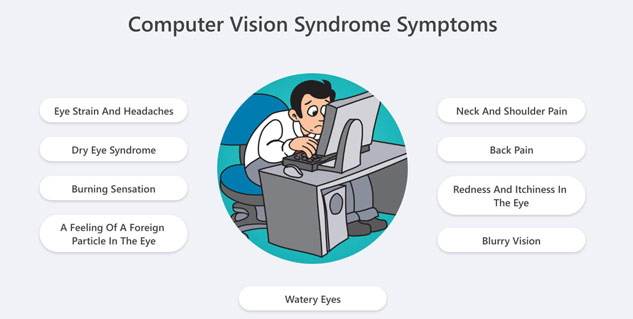
In this new age of being hyper-connected, screen-gazing has become part of our DNA. From working and learning to entertainment and connections, digital media is by our side all day long. And although these tools provide phenomenal benefit, too much screen time will erode the one sense most important to us: our sight. This has resulted in an increasing number of a condition called Computer Vision Syndrome (CVS), also commonly referred to as Digital Eye Strain.
Table of Content:-
But what on earth is Computer Vision Syndrome, and more importantly, what can you do to keep your eyes safe from its potentially irritating and uncomfortable effects? Let's find out more about this everyday modern complaint and understand some useful tips for protecting your eyesight.
What Is Computer Vision Syndrome?
Computer Vision Syndrome is not an individual illness but is a collection of eye and vision ailments caused by extended computer, tablet, e-reader, and smartphone use. More than reading a printed page, examining digital screens commonly entails a distinct set of visual requirements: less blinking, near distances, inadequate lighting and glare, small font and low contrast, and fluctuating images. All these factors combine to stress our eyes differently from the way that conventional reading usually does.

Also Read: Zaheer Khan And Sagarika Ghatge Welcome Baby Boy, Fatehsinh! Tips For Baby's First Summer
Identifying the Symptoms of CVS
Symptoms of Computer Vision Syndrome may also differ from one individual to another and can range from mild to severe. Common symptoms include eye strain, headache (usually tension-type), fuzzy vision (near or far), dry eyes (gritty or burning sensation), neck, shoulder, and backache (poor posture), sensitivity to light, and in some instances, double vision as well. Awareness of these symptoms is the beginning of the solution.
Practical Tips for Safety Against CVS
The silver lining is that Computer Vision Syndrome is frequently avoidable and treatable with simple changes in your lifestyle and pro-active habits. Here's how you can shield yourself:
1. Maximise Your Workspace
Place your monitor at arm's length and below eye level. Reduce glare with anti-glare screens or by adjusting lighting. Have an ergonomic setup with good chair support and correct wrist alignment. Use a document holder at the same height as your screen.
2. Practice the 20-20-20 Rule
Get up from your work station every 20 minutes and look at something 20 feet away for 20 seconds. This exercise relaxes eye muscles. Use a timer as a reminder.

Also Read: Have You Been Drinking For Years? Simple Ways To Keep Your Liver Healthy and Detox
3. Blink More Intentionally
Intentionally blink more often to moisten your eyes. Apply artificial tears if dryness is a problem.
4. Modify Display Settings
Modify screen brightness to suit your environment. Enlarge text size and contrast for easy reading. Use blue light filters, particularly at night.
5. Regular Eye Exams
Have regular comprehensive eye exams and notify your eye doctor of your use of digital devices. They can detect underlying problems and suggest solutions, such as computer glasses.
6. Break More Frequently
Besides the 20-20-20 rule, break frequently from all screens during the day to rest your eyes and body.
7. Use Good Posture
Don't slouch and use good posture to reduce related neck and back pain.
8. Use Computer Glasses
Your eye physician can prescribe computer glasses with special lenses to enhance vision at screen distance and cut down on glare.
Bottomline
Computer Vision Syndrome is common in today's tech-savvy world, but it shouldn't be a given. With knowledge of the causes and taking these preventive measures, you can cut your risk significantly and preserve your eyesight for the years to come. Prioritise eye care in your digital existence and indulge in technology without compromising on visual comfort and clarity.
Also watch this video
How we keep this article up to date:
We work with experts and keep a close eye on the latest in health and wellness. Whenever there is a new research or helpful information, we update our articles with accurate and useful advice.
Current Version